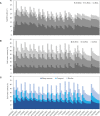Agro-morphological and biochemical responses of quinoa (Chenopodium quinoa Willd. var: ICBA-Q5) to organic amendments under various salinity conditions
- PMID: 37223820
- PMCID: PMC10200984
- DOI: 10.3389/fpls.2023.1143170
Agro-morphological and biochemical responses of quinoa (Chenopodium quinoa Willd. var: ICBA-Q5) to organic amendments under various salinity conditions
Abstract
In the Sahara Desert, due to drought and salinity and poor soil fertility, very limited crop choice is available for the farmers to grow crops. Quinoa (Chenopodium quinoa Willd.) has shown promising under such conditions in the South of Morocco, a true representative site of Sahara Desert. Soil organic amendments have the potential to minimize negative effects of soil salinity and improve crop production. Thus, this study aimed to elucidate the impact of nine organic amendments on quinoa (var. ICBA-Q5) growth, productivity, and biochemical parameters under saline irrigation water application (4, 12, and 20 dS·m-1). Results of the experiment indicate a significant effect of organic amendments on major agro-morphological and productivity parameters. Biomass and seed yield tends to decrease with the rise of salinity level, and organic amendments have improved productivity compared to the non-treated control. However, salinity stress alleviation was assessed by determining pigments concentration, proline content, phenolic compounds, and antioxidant activity. Therefore, the action of organic amendments varies from one level of salinity to another. Furthermore, a remarkably significant decrease in total saponin content was reached due to the application of amendments even at high saline conditions (20 dS·m-1). The results demonstrate the possibility of enhancing the productivity of quinoa as an alternative food crop under salinity conditions by using organic amendments and improving the quality of grains (saponin reduction) during the pre-industrialization process.
Keywords: growth; organic amendment; osmotic stress; quinoa; saponin; seed yield.
Copyright © 2023 El Mouttaqi, Sabraoui, Belcaid, Ibourki, Mnaouer, Lazaar, Sehbaoui, Ait Elhaj, Khaldi, Rafik, Zim, Nilahyane, Ghoulam, Devkota, Kouisni and Hirich.
Conflict of interest statement
The authors declare that the research was conducted in the absence of any commercial or financial relationships that could be construed as a potential conflict of interest.
Figures








Similar articles
-
How Does Quinoa (Chenopodium quinoa Willd.) Respond to Phosphorus Fertilization and Irrigation Water Salinity?Plants (Basel). 2022 Jan 14;11(2):216. doi: 10.3390/plants11020216. Plants (Basel). 2022. PMID: 35050104 Free PMC article.
-
Agro-Morphological, Yield and Quality Traits and Interrelationship with Yield Stability in Quinoa (Chenopodium quinoa Willd.) Genotypes under Saline Marginal Environment.Plants (Basel). 2020 Dec 13;9(12):1763. doi: 10.3390/plants9121763. Plants (Basel). 2020. PMID: 33322139 Free PMC article.
-
Techno-economic assessment of quinoa production and transformation in Morocco.Environ Sci Pollut Res Int. 2021 Sep;28(34):46781-46796. doi: 10.1007/s11356-021-12665-8. Epub 2021 Feb 25. Environ Sci Pollut Res Int. 2021. PMID: 33634400
-
Seed Dormancy and Preharvest Sprouting in Quinoa (Chenopodium quinoa Willd.).Plants (Basel). 2021 Feb 28;10(3):458. doi: 10.3390/plants10030458. Plants (Basel). 2021. PMID: 33670959 Free PMC article. Review.
-
Organic Amendments for Mitigation of Salinity Stress in Plants: A Review.Life (Basel). 2022 Oct 18;12(10):1632. doi: 10.3390/life12101632. Life (Basel). 2022. PMID: 36295067 Free PMC article. Review.
Cited by
-
Pomegranate-Quinoa-Based Agroforestry System: An Innovative Strategy to Alleviate Salinity Effects and Enhance Land Use Efficiency in Salt-Affected Semiarid Regions.Plants (Basel). 2024 Sep 10;13(18):2543. doi: 10.3390/plants13182543. Plants (Basel). 2024. PMID: 39339517 Free PMC article.
-
NaCl Stress Stimulates Phenolics Biosynthesis and Antioxidant System Enhancement of Quinoa Germinated after Magnetic Field Pretreatment.Foods. 2024 Oct 16;13(20):3278. doi: 10.3390/foods13203278. Foods. 2024. PMID: 39456340 Free PMC article.
References
-
- Abdrabou M. R., Gomah H., Darweesh A., Eissa M., Selmy S. (2022). Response of saline irrigated quinoa (Chenopodium quinoa wild) grown on coarse texture soils to organic manure. Egypt. J. Soil Sci. 62 (2), 169–178. doi: 10.21608/ejss.2022.146571.1511 - DOI
-
- Adolf V. I., Jacobsen S. E., Shabala S. (2013). Salt tolerance mechanisms in quinoa (Chenopodium quinoa willd.). Environ. Exp. Bot. 92, 43–54. doi: 10.1016/j.envexpbot.2012.07.004 - DOI
-
- Alandia G., Rodriguez J. P., Jacobsen S.-E., Bazile D., Condori B. (2020). Global expansion of quinoa and challenges for the Andean region. Glob Food Sec 26, 100429. doi: 10.1016/j.gfs.2020.100429 - DOI
-
- Alcívar M., Zurita-Silva A., Sandoval M., Muñoz C., Schoebitz M. (2018). Reclamation of saline-sodic soils with combined amendments: impact on quinoa performance and biological soil quality. Sustainability 10 (9), 3083. doi: 10.3390/su10093083 - DOI
-
- Ando H., Chen Y., Tang H., Shimizu M., Watanabe K., Mitsunaga T. (2002). Food components in fractions of quinoa seed. Food Sci. Technol. Res. 8 (1), 80–84. doi: 10.3136/fstr.8.80 - DOI
LinkOut - more resources
Full Text Sources

